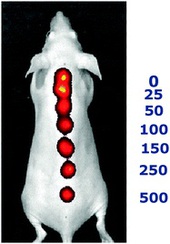Highlight
Nanosensors for in-situ continuous monitoring of glucose and sodium ions
Achievement/Results
In 2007, an estimated 24 million adults in the United States suffered from diabetes with an additional 57 million adults diagnosed with pre-diabetes. Diabetes causes a disruption in glucose metabolism leading to high and low glucose levels that lead not only to immediate implications but also cause long-term complications such as heart disease, stroke, and blindness. The only FDA-approved stand-alone device, the Finger-Stick Method, samples blood glucose intermittently missing hypo and hyperglycemic episodes. This method also leads to patient non-compliance because of the discomfort from blood sampling. Therefore, a diverse field of research has emerged that is focused on the development of a non-invasive continuous glucose monitoring device.IGERT trainee, Kate Balconis has designed fluorescent glucose-sensitive nanosensors to monitor glucose levels non-invasively through the skin. A minimally-invasive injection device would place the sensors in the upper layers of the skin similar to a tattoo. Then a handheld optical reader or smart phone device would read the fluorescence intensity of the sensors and provide glucose measurement for the user. The sensing technology is based off of ion-selective electrodes (ISEs) which have been utilized to detect and monitor physiological analytes in clinical settings. Bulk optodes are the optical counterpart to electronic ISEs. These optodes are composed of a plasticized polymeric core in which recognition elements, fluorophores, and additives are embedded. Optodes function through extraction of an analyte into the membrane by the recognition element. The extraction causes a concentration change within the membrane and alters the fluorescence of the optode. It has been demonstrated that the sensors monitore dynamic changes in glucose concentrations, could be tailored to respond within physiological range, and tracked changes in glucose concentrations in vivo. Recently, the extension of this technology has now been used for the detection of other molecules such as sodium ions.
Address Goals
Nanotechnology has opened up a new, previously unimaginable world in medicine, resulting in drug delivery systems with minimal side effects, safe delivery of drugs only to target site and early diagnosis of the disease state. Diabetes is a disease that has seen a rapid jump in the number of people it has affected and there is a constant need to develop new, rapid and continuous monitoring device. Therefore, a diverse field of nanotechnology-based research has emerged that that is focused on the development of a non-invasive continuous glucose monitoring device.






